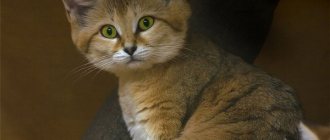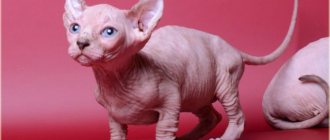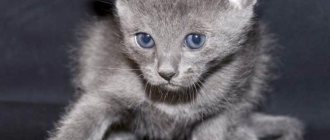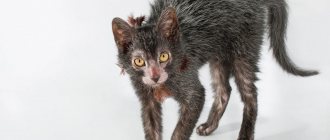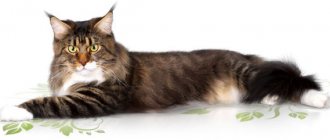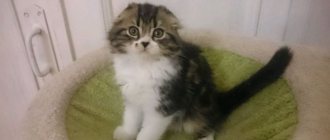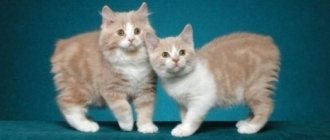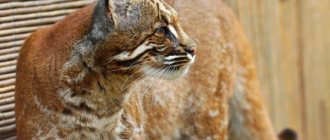Albino animals often attract human attention. Their snow-white fur makes them stand out among their other brethren. This gene is also found among cats. However, not all white cats are albinos, and not all albinos are completely white. Let's look at how albinism manifests itself in cats, what breeds have a genetic predisposition to albinism, and what are the health and behavioral characteristics of albino cats.
Albinism and how it appears
A pigment called melanin is responsible for the color of the fur, skin and iris of animals. It is he who determines the color of the animal, and is also responsible for the variety of coat colors among cats.
There are two types of melanin: Pheomelanin reflects sunlight, causing the fur to appear reddish or reddish. Eumelanin absorbs sunlight and gives the coat its black color.
In the skin, fur and iris, these two types of melanin are contained in different proportions - which gives us a variety of animal colors. The color of an animal is genetically predetermined and in most cases directly depends on the color of the parents and more distant ancestors.
The main feature of albinos is that there is no melanin in their body at all. This leads to the fact that in most cases the fur of such an animal appears completely white, and the eyes appear red. This is due to the fact that there is no pigment in the albino iris, and therefore it is transparent, and we can see the inside of the eyeball and blood vessels.
Albinism is often associated with a genetic mutation. A recessive gene is responsible for the inheritance of this feature. This means that in order to produce albino kittens in a litter, both parents must have this trait. If one of the parents is not albino, most likely all kittens will be born colored.
Albinism is directly related to genetic abnormalities, and therefore such kittens are often born with various pathologies. For example, deaf individuals are often found among albino cats, and some kittens have serious vision problems. Therefore, when buying an all-white kitten, you should immediately check that it reacts to sounds and light, otherwise you may buy an animal with special features.
Albinism can be complete or partial. Full albinos are completely devoid of melanin, and therefore they can only have a white color. Partial albinos may have colored areas of their fur or colored eyes.
There is a so-called W gene. Its presence in the body causes a malfunction in which white begins to dominate the color. Such cats have melanin in their bodies, but due to the presence of the W gene in the body, all its manifestations are completely or partially suppressed.
Animals with complete and partial albinism can be distinguished by their iris. In complete albinos it has a reddish tint, but in partial albinos it can take on different colors. If a white cat has eyes of different colors, then this is a manifestation of the work of the W gene. Moreover, cats with the W gene are often born completely or partially deaf. If a white cat has only one blue eye, then she may be deaf in only one ear. Studies have shown that about 20% of white cats with non-blue eyes are born deaf. About 40% of cats with one blue eye may be deaf. About 70% of cats with both blue eyes are born completely deaf.
We recommend the article: Why can a cat sneeze?
Albino animals are rare in the wild. Due to health problems, they live much shorter lives. The white color does not allow such animals to camouflage effectively, which means they are vulnerable to predators. White predators are much more noticeable, which can lead to difficulties during the hunt. During mating, females show preference for colored males.
However, people consider animals with completely white fur to be very beautiful. Therefore, albinos are specially bred. Among cats, there are entire white lines that are bred as a result of selection of individuals with partial albinism.
Albino cat appearance
Not every white cat can be considered a complete albino. It should be remembered that this is a genetic mutation, the presence of which can be determined by the color of the coat, paw pads and tip of the nose. There should be no pigment on any of these areas of the body.
The most important sign of a true albino is the color of the iris. Full albinos have red, pink, or pink-blue eyes. Translucent vessels can be seen through the iris. If the iris is well colored in blue, green and other colors, then such an individual has partial albinism. Among cats, complete albinos are extremely rare. It is believed that one complete albino is born among cats per 10 thousand individuals. At the same time, there are breeds among which albinos are much more common. This is due to their genetic characteristics.
With different eyes
There are such amazing snow-white creatures that have two eyes of different colors . Most often, one of them is blue, and the other has a shade of brown. For example, golden or light brown. These animals look very unusual, which means they attract people’s attention.
What does this diversity mean? It suggests that the genetic failure did not occur completely, but partially. As a rule, the golden organ of vision sees well, but the one with a bluish tint sees poorly. It often happens that the ear on the side of the blue pupil cannot hear. Deafness does not necessarily accompany blue eyes, but it is quite common.
Health Features
In addition to the congenital health problems that often accompany albinism, individuals with this mutation have rather fragile health. They are more prone to colds and are afraid of cold weather and drafts. Areas of the skin that are devoid of pigment and not covered with fur are very vulnerable to the sun. Albinos often suffer from sunburn.
Albinos have a very fragile immune system, and therefore they are more vulnerable to various infections. That is why such cats must be vaccinated without fail. In addition, it is not advisable to keep them with painted animals, which can easily transmit various diseases to their unpainted counterparts.
The albinism gene directly affects the functioning of some internal organs. For this reason, albino kittens are often born deaf and blind. This is due to genetic characteristics, and therefore it is impossible to cure such an animal.
To check that an albino kitten is completely healthy, you need to play with it. The baby should respond to sharp sounds - such as cotton or the rustling of a toy. If the kitten carefully follows the movements of the toy with its eyes, we can conclude that everything is fine with its vision. If a kitten has a hearing or vision problem, you need to understand that such an animal will need special care and increased attention from the owner.
The albinism gene may affect musculoskeletal health. The genetic characteristics of albinos are often associated with impaired formation of cartilage tissue, which is why the animal may suffer from problems with joints, claws and teeth. Some diseases can develop with age, so the health of an albino cat must be monitored very closely and periodically taken to the veterinarian for examinations.
Albino cat personality
The character of an animal rarely depends on color. So albino cats may be no different from their colored counterparts. Although it is worth noting here that the albinism gene can affect the health of the animal, but this point is already associated with changes in behavior.
Albino cats may be highly sensitive to sounds and bright lights. They are more vulnerable and therefore need attention and care. Such cats can follow their owner everywhere and get nervous if he is not nearby. In unusual situations (when moving, new animals and small children appearing in the family), albino cats can experience extreme stress.
We recommend the article: Why does my cat's belly sag?
Albinos can be more cowardly. If guests come to the house, they prefer to hide. Other cats may dominate them. Such animals are very anxious and modest. At the same time, they can be quite intrusive towards their owner, as they need increased attention.
Maintenance and care
Albino cats are very vulnerable to various diseases, and they also have fragile health. That is why such animals need more careful care. When purchasing an albino pet, the owner must be prepared for the fact that such a cat will have to pay much more attention than its colored counterparts.
Due to their fragile health, albino cats should only be kept indoors. Walking on the street is contraindicated for them. On the one hand, they are vulnerable to various infections, as well as drafts. On the other hand, sensitive skin gets sunburned easily. In addition, walks can be a source of stress for rather timid albinos.
It is advisable for the cat to have its own place at home. You can buy a special house in which your pet can hide and feel protected. Albinos really need the attention of their owner. If the owner is at work all day, the animal may become very bored and even stressed. This is especially true for cats with special needs - deaf and blind, who need much more attention.
Diagnostics
Your veterinarian may order some tests, which include testing for the condition that causes red eye. The doctor will take your medical history and perform a physical examination to determine the underlying problem.
A complete ophthalmic examination is necessary to find the source of the eye redness. Your veterinarian may refer your pet to a veterinary ophthalmologist to evaluate your pet's condition using specialized equipment. During an eye exam, the following tests may be performed:
- Schirmer test for measuring tear quantity
- Fluorescein staining of the cornea to detect abscesses
- Tonometry to measure eye pressure
- Examination of the inside of the eye under magnification
- Scraping of inflamed tissue (eg, conjunctiva and cornea) for cytological examination for the presence of inflammation
- Eyelid scrapings to detect parasites
- Taking tissue samples to check for infections
- Biopsy of inflammation around the eyes
Nutrition
It is not advisable to feed albino cats natural food. They have much more sensitive digestion, and therefore some foods may be poorly digested and cause a negative reaction. Finding the optimal diet for such animals is much more difficult. In addition, some foods can cause the animal's fur to change color - a snow-white cat can easily turn yellow.
Dry and canned food is good for albinos. It is advisable to buy food labeled “for sensitive digestion.” Preference should be given to premium and super-premium class. Economy class food not only will not bring any benefit, but can, on the contrary, lead to digestive disorders.
Hygiene
Albinos, like other cats, usually manage their own hygiene on their own. However, dust and dirt are much more noticeable on snow-white wool than on dyed wool. Not all albinos cope with maintaining their fur in proper form. In this case, owner intervention is required. It is not advisable to bathe cats frequently. Frequent exposure to water and detergents can cause the skin to dry out and become more prone to dermatitis. Dust from wool can be removed with a damp cloth.
Once every couple of months, the animal can be completely bathed. During the procedure, special shampoos should be used. Human cats are not suitable. They may have odors that are irritating to the animal. In addition, they contain components that can lead to irritation on the pet’s skin. It is worth noting that there are special shampoos for albino cats that help whiten their fur. After bathing, your pet should be protected from drafts. You can't let him go outside with wet fur.
You should also monitor the condition of the eyes, ears, fangs and claws. You can wipe your eyes with a cotton pad moistened with clean boiled water. Ears can be cleaned with cotton swabs, and claws can be cut with a nail clipper. Veterinarians also advise periodically brushing your pets' teeth. To do this, you need to use a special toothpaste and brush. A cat should be taught to brush its teeth from childhood.
We recommend the article: Why the cat’s eye is cloudy: causes, treatment methods
What to do at home
Keep your cat at home as quiet as possible to stop bleeding, allow the hyphema to settle in the eye, and reduce the risk of further bleeding. It may be necessary to limit your cat's physical activity for 7-10 days.
Since in some cases vision deteriorates, it is recommended not to allow the cat to go outside without supervision until complete recovery.
Do not give your cat over-the-counter human medications such as Visine or other ophthalmic medications designed to reduce eye redness or irritation, as these products are not effective for hyphema.
Contact your veterinarian as soon as possible, because some causes of hyphema are dangerous not only for the eyesight, but also for the life of the animal.
Similar articles
Recently, veterinarians have observed a sharp increase in pancreatic diseases...
Mycoplasmosis in cats is a severe infectious disease that requires the intervention of veterinarians. Even…
Leave a request for treatment for your pet right now!
Albino cat breeds
Albinos can appear among different breeds. And yet there are breeds among which such individuals appear much more often. Some breeds even appeared as a result of breeding individuals with albinism. It is not easy to get snow-white individuals, because a recessive gene is responsible for this color. In addition, during the selection process there is a high number of cullings. Since the albinism gene often leads to deafness, animals with hearing impairment cannot subsequently participate in breeding.
Breeders rarely use individuals with complete albinism for breeding, as they have a number of health problems, which can only intensify during the selection process. But the gene for partial albinism is found in many breeds. Due to selection, the following breeds can boast a completely white color: Turkish Angora, Foreign White, Kao Mani. There are also breeds among which individuals with incomplete albinism are much more common - these are the Siamese, Burmese, Thai, Balinese, Tonkinese and Himalayan.
Khao-mani
The breed comes from Thailand. It is very rare and considered expensive. These are snow-white cats with short hair. Their main feature for which the breed is valued is their multi-colored eyes. There are individuals with the same eye color, but cats with heterochrony are valued much more. In Thailand they are believed to bring good luck.
Kittens are often born with a small dark spot on their head that fades over time. With age, the animal becomes completely white. Most individuals have hearing problems. They are often deaf in the ear on the side of the blue eye.
Foreign white
This breed is related to Siamese cats. Breeder Patricia Turner from the UK set herself the goal of breeding a cat with the body of a Siamese and snow-white fur. In addition, she set herself the goal of minimizing the appearance of deaf individuals among the representatives of the breed. As a result of long work on selection, the goal was achieved.
Foreign Whites are very similar in character and characteristics to Siamese cats. They are smart and can learn commands. These cats are very talkative. Deaf individuals are practically never found.
Inflammation of the eyelids
The disease is caused by fungal and bacterial infections. The main signs of inflammation of the eyelids or blepharitis:
- The eyelids are swollen and inflamed.
- Over time, baldness of the eyelids begins to occur.
- Your pet rubs his eyes all the time and is bothered by itching.
- The eyes are “crying.” The discharge is purulent or mucous. The cat has a red eye or both. Most often, both eyes turn red.
- Strabismus may occur.
- The pet blinks frequently.
How to help your pet? Do not hesitate to visit a veterinarian. It is possible that surgery will be required. It is carried out in severe cases of the disease. The rest prescribe antibiotics, ointments, and antifungal drugs.
